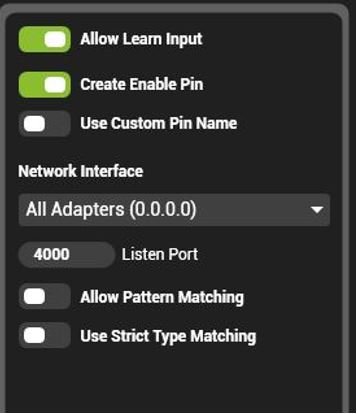
OSC, or Open Sound Control is an open-ended network protocol designed to connect musical instruments such as synthesizers together. http://opensoundcontrol.org/introduction-osc Due to its flexibility, OSC is an easy way to send commands from 3rd party devices such as an iPad application to Hippotizer. (TouchOSC is popular for this). OSC sends strings of data, (words basically) across the network which Multicontroller can listen to.
OSC input uses a Text Mapping.
- Allow Learn Input: If enabled, the input can be used to automatically assign to a mapping with the learn button. It is advisable to disable allow learn input on sources that are constantly sending data as it will interfere with other sources associating.
- Create Enable Pin: Creates a new pin (Bool) to allow the controller to be turned on or off.
- Use Custom Pin Name: Allows user to name enable Pin.
- Network Interface: Choose which adaptor to use for receiving OSC data
- Port: Choose which port to use for receiving OSC data, this must match the sender’s settings.
- Allow Pattern Matching: Enables OSC Pattern Matching as defined in the OSC spec:
- ‘?’ in the OSC Address Pattern matches any single character
- ‘*’ in the OSC Address Pattern matches any sequence of zero or more characters
- A string of characters in square brackets (e.g., “[string]”) in the OSC Address Pattern matches any character in the string. Inside square brackets, the minus sign (-) and exclamation point (!) have special meanings:
- two characters separated by a minus sign indicate the range of characters between the given two in ASCII collating sequence. (A minus sign at the end of the string has no special meaning.)
- An exclamation point at the beginning of a bracketed string negates the sense of the list, meaning that the list matches any character not in the list. (An exclamation point anywhere besides the first character after the open bracket has no special meaning.)
- A comma-separated list of strings enclosed in curly braces (e.g., “{foo,bar}”) in the OSC Address Pattern matches any of the strings in the list.
- Any other character in an OSC Address Pattern can match only the same character.
Source: http://opensoundcontrol.org/spec-1_0 - Use Strict Type Matching: If strict type matching is on, data types from OSC must match exactly the data type of the pin to be set. For example, float messages will only apply to float pins even if the address matches. This is off by default as it can lead to undesired behaviour. TouchOSC for example only sends float messages, so enabling strict type matching would make it impossible to control Int pins.


Hinterlasse einen Kommentar.